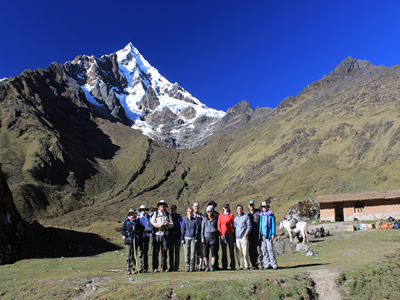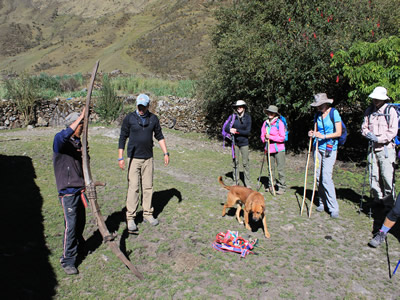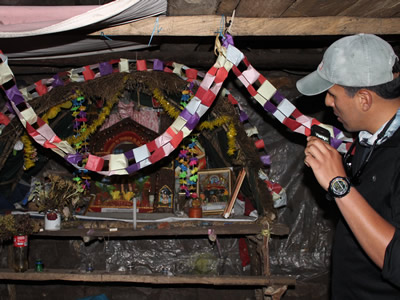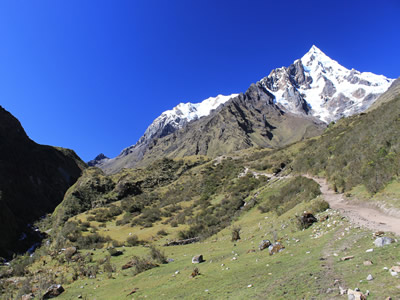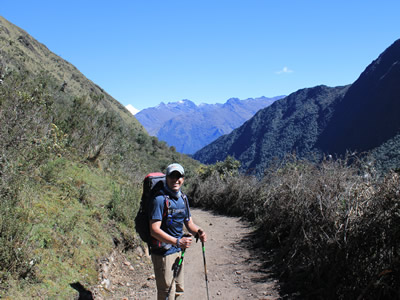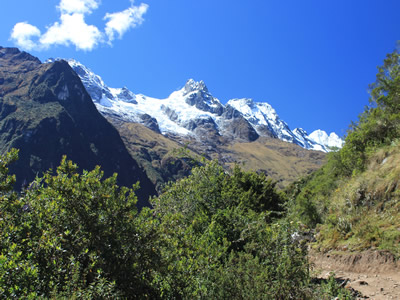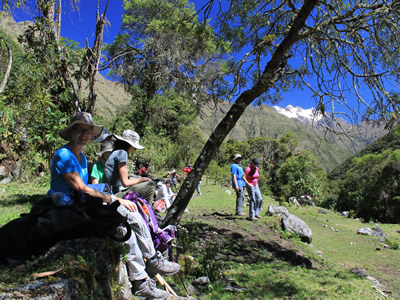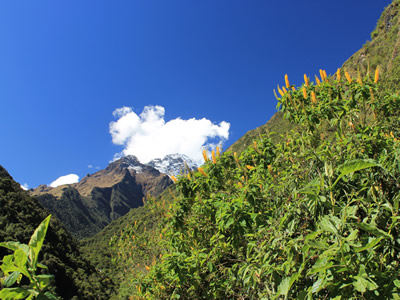Peru - Descending from the high country
Each of the lodges on the trek was unique. The first lodge that we stayed at, Salkantay Lodge, was the largest with twelve guest rooms. It also seemed to have more rooms for the help which added to its size. It was built in a circle around a central outdoor courtyard and had three floors. It was also the only one of the four that can be reached by road so getting the materials in for construction wasn't a problem. Bringing in the supplies for its operation requires a long drive on a rough road but at least itcan be done by vehicle.
After our hike over the pass we were staying at Wayra Lodge. At 12,936 feet it was the highest of the four lodges, higher than the summit of the tallest mountain in Idaho. This lodge was the most remote of all - it was over five miles to the nearest road. Everything used in the construction of the lodge had to be carried in all that way by horses. All supplies, such as food and fuel, had to be packed in as well. On our hike over the pass we had seen how many pack trains were on the trail. The most common cargo seemed to be propane tanks. It was used to cook, to heat the building and to run the generators for electricity. Given how heavy propane tanks are, it was a lot of effort to get all those tanks in to the lodge and get all the empties out. I'm sure if the horses could talk they would complain loudly about having to carry all that much weight back and forth.
This lodge was circular like Salkantay Lodge but was much smaller. With only six rooms it was just a single story. It had a single dining room-lounge-kitchen area. If you weren't in your room, that's where you were. After the hot tub and showers everyone was there waiting for dinner. This was where I noticed that there were two distinct groups on our trip. About half had smart phones, tablets or even a small PC and were hunched over them. The lodges, even though they were very remote, had wifi with satellite internet access. The other half of the group didn't have their digital devices and it turned out hadn't even brought them along. It was nice that people had a choice. For some people it was important to stay connected with people back home, giving them updates every night and pictures on Facebook. For others it was better to be far away, in the remote Andes and far from their normal world. For the record, Sandy had her iPhone along while I left my high tech at home.
Across from the lounge was the semi-open kitchen area. It had a very large hooded oven that reminded me of the big ovens that you see at pizza places. The impressive part was the hood. It was a single large piece that somehow had been hauled all those miles and over the pass. The embarrassing part was that it wasn't used. After it was installed it turned out that too much smoke escaped out into the room. I hope that no one told the horses who had to haul that thing up there. Although the cooks had to use the conventional kitchen we had a delicious steak dinner. I thought it was the best meal of the trip.
The next day was another beautiful, cloudless morning with impressive mountain scenery. The view of Humantoy from the northwest was spectacular. It looked like a totally different mountain. From Salkantay Lodge and Humantay Lake it had been fantastic - a long ridge with an incredibly steep, icy face on it's south side. Since then we had walked two hundred and seventy degrees around the mountain and were now looking at it edge on. From this perspective it looked like a narrow spire. Both views were beautiful and I'm not sure which aspect of the mountain I liked best. Look at the photos and decide for yourself.
We took our time getting started. This hike was going to be six miles - the shortest of the entire trip. Even better it was all going to be downhill. The next lodge was 3600 feet lower. No one felt badly about that - an easy day after the long, hard day crossing the pass seemed like a good idea to everyone. Since the hike was shorter there were some extra activities planned for the day. Just as we started out we took about forty five minutes to tour a farm right behind the lodge. When we reached the next lodge there was another special activity planned but I'll cover that in the next post.
The local people who lived next door had two small houses and a storage shed. The family that worked at the lodge lived in one house while the grandfather lived in a smaller, older house next door. They still supplemented their work at the lodge with some farming. They had some animals - there were lots of chickens running around the houses (and probably some guinea pigs in the kitchen). They also grew potatoes in small patches scattered around the area. I couldn't figure out why they chose certain spots and not others. For example there was a small potato patch clearly visible about a quarter mile away and several hundred feet up the hillside. It certainly wasn't flatter than the valley floor. There was more water in the nearby stream running through the bottom of the valley. It certainly took a lot of work to reach from their house. It was a mystery to me but then I am certainly not a man of the soil.
One of the folks who lived there showed us some of his tools. He had an intersting home made tool for breaking the soil to plant potatoes, an eighteen inch blade mounted on the end of a six foot long curved stick with two wooden cross pieces. He could turn the soil by pushing with his foot against a cross piece the way you do the blade of a regular shovel. We also got a look at the inside of the houses. It must be a hard life so high in the mountains, although I'm sure it has gotten better with the work provided by the lodges. The money the people make allows them to buy extras they can't produce themselves.
We also got to check out the generator shed behind the lodge. They had a long row of propane tanks, forty in all, connected to the generator. No wonder there were so many horses carrying propane tanks on the trail the day before. One of the lodge workers would start the generator every morning at 6 am and it would run until 11 pm when it was turned off. That meant that we had to keep a flash light or head lamp next to the bed in case we needed to get up in the middle of the night to go to the bathroom. There was no electricity so the lights didn't work during the wee hours.
After the tour we headed down the trail. Although not as much work as going up hill, going down a steep trail was work too. It had been warm when we were at high elevations. By midmorning, as we descended, it started to get hot. Still it was great hiking. As we got lower the hills were green with vegetation. Behind us we could still see icy, snow-covered, high peaks. Jairo stopped frequently to point out something of interest, often an interesting flower. There were lots as we descended, especialy orchids. There were also huge bushes of golden flowers that in places covered the hillside.
We moved slowly but it took us longer than I expected to reach our snack spot, which was at an Inca archaelogical site. There were a series of terraces that were separated by stone walls that had been built by the Incas. For us they were a convenient spot to sit in the shade of a nearby tree, dangling our legs over the edge of the wall, while we ate our snacks. It was a pleasant spot to stop.
Then it was time to get on the trail again. Sandy and I did ok but some people in our group with knee trouble had difficulty with the steep downhill. Finally Jairo pointed out where the lodge was - at the end of the valley we were descending, where it opened out into a larger intersecting valley. Unfortunately as we got closer we realized that we were on the wrong side of the stream from our destination, several hundred feet up the side of the valley. The main trail continued to the village of Colpapampa, which was only about half a mile from the lodge. But that was as the crow flies. There was a gorge that was several hundred feet deep in between. Eventually we had to turn off and drop down to the river. Then we had a long, slow, hot climb back up the elevation that we had just given up. A steep climb at the very end of a hike is never welcome. But finally we were there, at Colpa Lodge. Again we were met by the staff with wet towels and glasses of tea to refresh ourselves. Now that's how to hike!
The hike had taken longer and was more effort than I expected. Maybe it just seemed that way because I was expecting an easy hike. Maybe I was a little tired from the day before. But it was only midafternoon, still early. We had a special treat planned for lunch, a pachamanca. It's a Peruvian-style barbecue with food buried in the ground that is cooked by hot rocks, kind of like a pig roast in the US. It would be our big chance to try the traditional Peruvian delicacy, guinea pig. Juan told us that "it tastes like CHEE-ken". I'll cover that in the next post.
